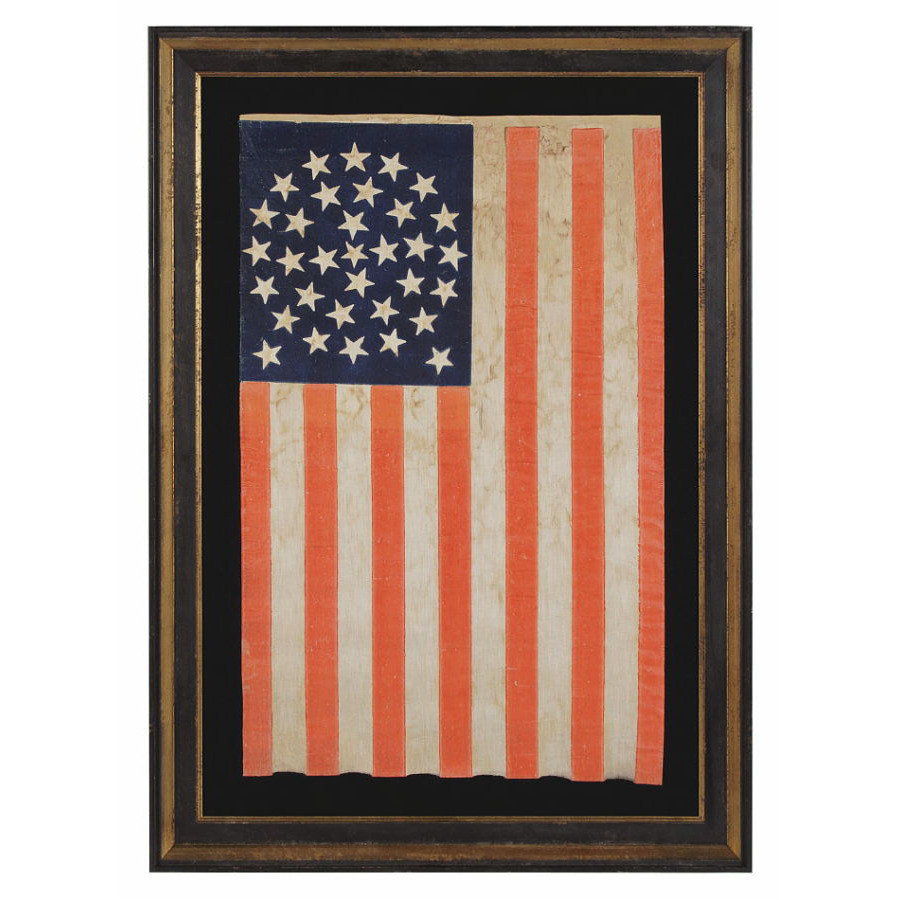
| |
33 STARS IN A MEDALLION CONFIGURATION ON A LARGE SCALE PARADE FLAG, AN EXTREMELY RARE EXAMPLE, OREGON STATEHOOD, 1859-1861 |
|
| Available: |
Sold |
| Frame Size (H x L): |
53.25" x 37.25" |
| Flag Size (H x L): |
42.25" x 26.5" |
|
| Description....: |
|
This 33 star American parade flag, printed on coarse, glazed cotton, is an especially large and visually attractive example and is one of perhaps just ten or so known to exist in this rare style. The design consists of a cross of 5 stars in the center, surrounded by 2 consecutive wreaths, with 2 flanking stars outside the primary pattern, placed toward the fly end. Typically there are 4 flanking stars outside this type of pattern, placed one in each corner. The inclusion of only two was intentional, leaving room for the easy addition of two more states. Flag-makers knew that more Western Territories were soon to follow and eagerly anticipated their arrival.
This particular flag was found with a small group of flags of the same kind. Before their discovery, only three others were known in this style. One was formerly part of the collection of Boleslaw and Marie D'Ostrange-Mastai, who held one of the most important private collections of American flags in the country and whose book, "The Stars and the Stripes" (knopf, New York, 1973), was the first major reference on the subject of flag collecting. The Mastai example was not pictured in their text, but was a part of their substantial, undocumented holdings.
The 33rd state, Oregon, entered the Union on February 14th, 1859. The 33 star flag was official from 1859-1861, and was thus still the official flag when Ft. Sumter was fired upon on April 12th of that year. This event marked the beginning of the Civil War, and a 33 star flag was flying at Ft. Sumter during the attack. Because the 34th state, Kansas, had already acquired statehood on January 29th, 1861, the 34 star flag was to become official on July 4th. For this reason, 33 star flags were not generally not produced for the war, which would last until 1865, and 33 star flags were generally made pre-war. It is for this reason that 33 star examples are far-and-away more scarce than their 34, 35, and 36-star counterparts.
Flags made prior to the Civil War comprise less than one percent of 19th century flags that have survived into the 21st century. Prior to the Confederate attack on Fort Sumter, the Stars & Stripes was simply not used for most of the same purposes we employ it in today. Private individuals did not typically display the flag in their yards and on their porches. Parade flags didn't often fly from carriages and horses. Places of business rarely hung flags in their windows. Private use of the national flag rose swiftly during the patriotism that accompanied the Civil War, then exploded in 1876.
Even the military did not use the flag in a manner that most people might think. The primary purpose before the Civil War was to mark ships on the open seas. While the flag was used to mark some garrisons, the flags of ground troops were often limited to the flag of their own regiment and a Federal standard. Most people would be surprised to learn that the infantry wasn't authorized to carry the Stars & Stripes until 1837. Even then it was neither required nor customary. It was not until the Civil War took place that most U.S. ground forces carried the national flag.
Note how the strong shades of indigo blue sun fire red create stark contrast that is especially attractive. When combined with the large scale, a pre-civil war star count, extreme rarity and interesting star pattern, the result is a flag worthy of any major collection.
Mounting: The flag has been placed in its correct vertical position, with its canton in the upper left. It has been hand-stitched to 100% cotton, black in color. The cotton has been washed to remove excess dye. The fabric was also heat-treated and an acid-free agent was added to the wash to further set the dye. The flag was then placed in a black-painted, hand-gilded and distressed Italian molding. The glazing is U.V. protective plexiglass.
Condition: There are minor to moderate losses along the hoist where the flag was affixed to its original wooden staff, and there are a few minor tears with losses elsewhere in the white stripes. Fabric of similar coloration was placed behind the flag for masking purposes. There is minor to moderate foxing and staining throughout. Many of my clients prefer early flag to show their age and history of use. |
|
|
|
| Collector Level: |
Advanced Collectors and the Person with Everything |
|
| Flag Type: |
Parade flag |
|
| Star Count: |
33 |
|
| Earliest Date of Origin: |
1859 |
|
| Latest Date of Origin: |
1861 |
|
| State/Affiliation: |
Oregon |
|
| War Association: |
1777-1860 Pre-Civil War |
|
| Price: |
SOLD |
|
| |
Views: 1267 |
|
|
|

